Media
Review Template
Title
plus author’s full name and affiliation
Coordintor:
Musa Nushin
Abstract
(not more than 200)
The
abstract is a crucial element of any academic article; it not only summarizes
your paper but also helps it reach the right audience. Your abstract should be
written in both English and Persian; it should appear in block format, single
spaced and justified. The abstract should include: 1) a brief (one or two
sentence) introduction; 2) the media selected for the review and the
significance/ purpose of the review/ selection; 3) major findings and; 4)
recommendations.

Introduction
(approximately 450 words)
The
introduction should give a broad view of the field of educational technology
with a focus on the role of technology in second/ foreign language education.
It then narrows the focus on the media selected for the review and how and why
the review can contribute to second/ foreign language learning and teaching.
Description
(approximately 550 words)
The
authors need to describe the media tool as accurately as possible, preferably
using photos and graphics that make the description engaging and interesting to
read. The description should tell the readers about where they can
find/download the media, what its different sections are and what the features
and purposes/functions of each section are, etc.
Evaluation
(approximately 350 words)
In this
part the overall value of the media review and its contribution to second/
foreign language is given, followed by its strengths and/or possible
weaknesses. The authors can offer their own and research-supported suggestions
on how those shortcomings can be removed or taken care of.
Conclusion
(Approximately 250 words)
The
review ends with a conclusion that summarizes the main points and make specific
recommendations on the use of the media for second/ foreign language learning
and teaching.
References
References
should be up to date and written in APA style. The number of references should
not exceed 10.
MosaLingua:
A Multilingual Mobile Language Learning Application
Abstract
The
hectic lifestyle of modern age may not allow us to physically participate in
different classes and courses that we need. Therefore, the tendency to use
mobile-assisted learning has recently been expanding particularly among second
language (L2) learners. Numerous language learning mobile applications (apps)
have been produced to make L2 learning more effective, meaningful, and
convenient. One of these apps is MosaLingua, on the effectiveness of which the
following review has been conducted with the aim of providing a comprehensive
explanation about its positive and negative points.
Introduction
No more
than a decade ago, the most exciting thing one could do with his/her mobile
phone was to download a ringtone; however, these days, iPhone and Android users
from different communities are able to download thousands of apps from the
Internet and start using them (Jones, 2011). These technological advances have
also prompted educators and researchers to get involved in improving teaching
and learning conditions by utilizing mobile-assisted learning (Shen, Wag, &
Pan, 2008). There is a subset of
mobile-assisted learning called mobile assisted language learning (MALL), which
is flourishing to the benefit of the field of L2 learning (Ballance, 2012;
Chinnery, 2006). In fact, the evidence for the effectiveness of MALL apps in
teaching and learning of L2 has been provided by a large number of studies (See
Burston, 2013 for a review); therefore, mobile devices such as smartphones,
tablet computers, laptops, iPads , can be made more useful for language
learners if some MALL apps are installed on these devices. The users can then
study regularly even if their time is fairly packed due to work and family commitments
(Eqbali & Nushi, 2017). There are a number of MALL apps (e.g., Busuu,
Babbel, and Duolingo) which freely allow learners to learn a new language and
socialize with learners from all over the world. Although these apps vary in
many aspects from one another, they all have been designed to fulfill the task
of mobile learning and make the process of L2 learning as convenient as
possible. Considering the range of options available it might be difficult
sometimes to choose only one app from a variety of language learning apps. The
present paper aims at investigating the offered options of one of these apps
named MosaLingua for learning an L2.
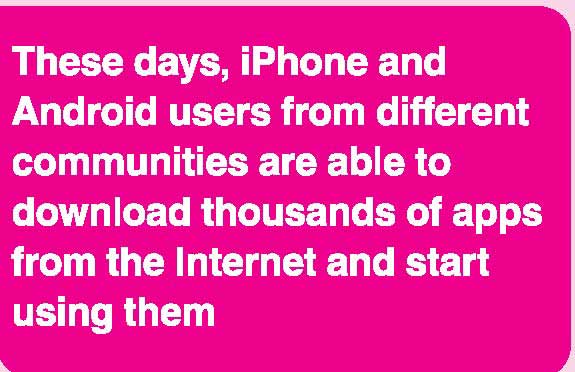
A
detail-oriented description
MosaLingua
can be downloaded for free from App Store or Google Play and is accessible to
learners in Android or iOS. Its overall rating is 4.7 which is fairly high
among language learning apps available. It comprises a wide range of major
European and Asian languages including German, Portuguese, Italian, Spanish,
French, English, and Russian. It also has some other applications which work on
TOEIC and TOEFL tests.
As soon
as one first launches the app, they are supported by a teacher who accompanies
them during the whole course of learning. The teacher sheds light on almost all
facets of the app from explaining how to use it to introducing and drilling
learning materials. In the following step, there is a short placement test
through which learners are able to choose their appropriate level of ability
(there are 8 levels plus a dialogue section defined in the German version of
this app). Afterwards, as shown in Figure 1, users are provided with some
questions regarding the preferred period of daily learning and the number of
everyday flashcards about their area of interest. It is worth noting that the
option of Learning Settings is always available and throughout the course,
whenever needed, the level can be changed and the learning time can be
adjusted.
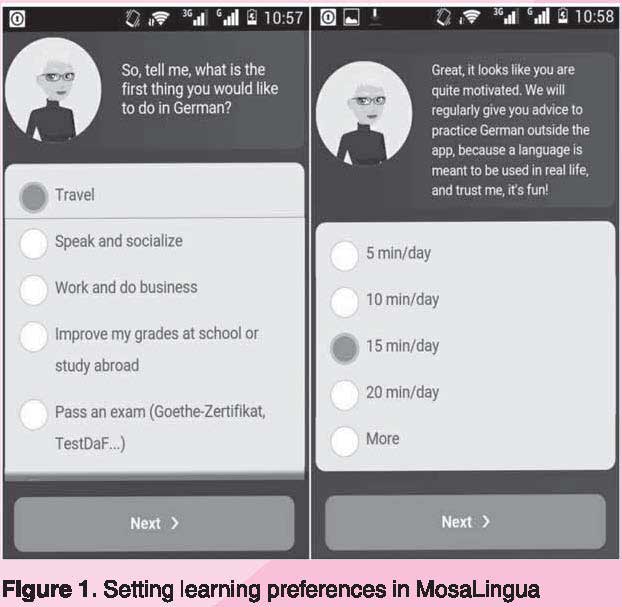
Like
many other language learning apps, this app teaches words through flashcards.
As it is displayed in Figure 2, there are four stages involved in learning sets
of flashcards. In the first stage entitled Listen & Pronounce, learners are
supposed to listen and repeat what the teacher says. There is a recording icon
next to the teacher’s voice. By holding it, learners are able to record their
voice to practice pronunciation. In the second stage, Memorize, learners
memorize the practiced words by reviewing them several times. In the subsequent
stage with the title of Write, learners practice writing of the same words by
typing them, and at the end, there is a Self-Evaluation part as the ending of
the first set of flashcards. As it can be observed, MosaLingua uses visual and
audio memories, and its word/ phrase reviews are at just the right time in
order not to forget the learned vocabulary.
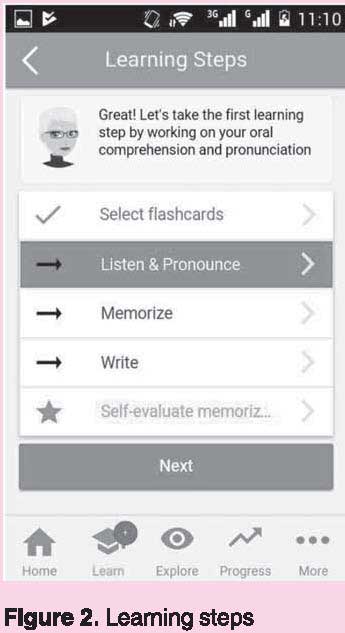
There is a variety of exercises in the app the
main focus of which is on oral and written skills (i.e., productive skills).
Video and audio conversations along with their subtitles are available and are
recommended to learners when they are free and finished with determined daily
learning. Moreover, there is a bonus section, as can be seen in Figure 3,
including proverbs, learning advice, language facts, fun facts, jokes, and
quotes. As the title of the section reads, bonus options are unlocked and given
to users as a bonus or a reward to their effective learning. Learners are able
to add each of these items to their flashcard deck if they want. This bonus
section in addition to optional educational clips and podcasts illustrate that
MosaLingua follows its slogan: Learn words, enjoy the world, and has made an
effort to create an enjoyable and relaxed learning atmosphere for learners.
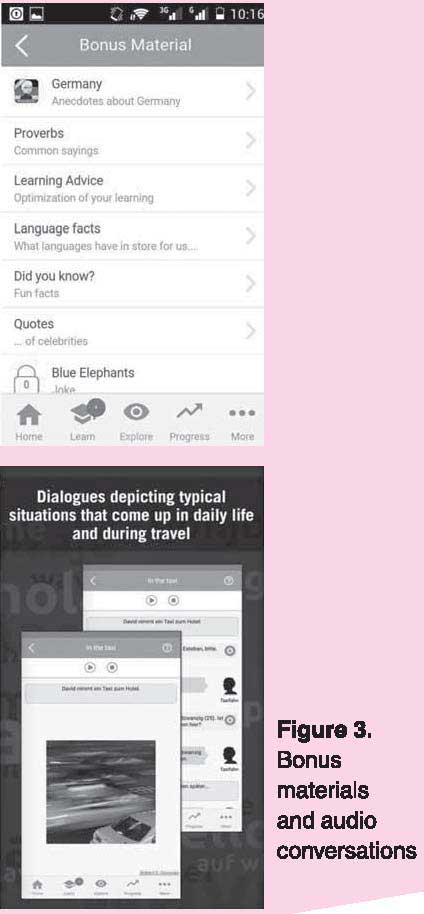
According to MosaLingua website, the dominant
teaching method of this application is based on the tenets of cognitive theory
for the most suitable results. It should be noted that the grammar structures
are not instructed deductively; instead, they are taught through examples in an
inductive way within SRS system (Spaced Repetition System). SRS is a complex
flashcard method that presents the information to learners and makes sure that
it remains constantly fresh in their mind (Lewis, 2017). It has been claimed by
MosaLingua developers that this system allows learners to memorize vocabulary
much more quickly. This claim has been supported by the results of numerous
studies (e.g., Baturay, Yıldırım, & Daloğlu, 2009; Kang, 2016). Lewis
(2017) notes in his article that the best way for effective vocabulary
acquisition seems to be hearing and applying new words in context with native
speakers. Having this in mind, he also mentions that SRS might be a faulty
system since one hears words in isolation and in an artificial way without
learning how to use them. As a result, it is not enough for effective learning.
Moreover, SRS is very likely to turn into rote learning if applied in this
manner. That is why Lewis, as an experienced educator, prefers an image
association of the word and/or to think of an example for the word to use it in
its suitable context.
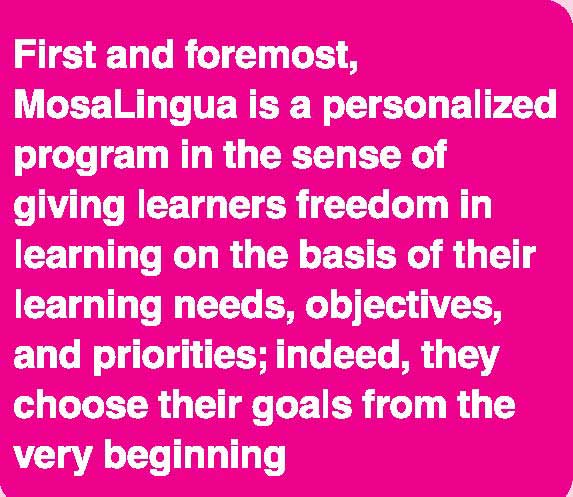
Strengths
First
and foremost, MosaLingua is a personalized program in the sense of giving
learners freedom in learning on the basis of their learning needs, objectives,
and priorities; indeed, they choose their goals from the very beginning. Certainly, holding a business-based or a
college-based view makes some differences in teaching and learning methods and
contents. As mentioned above, learners can choose words and phrases they intend
to learn simply by exploring the categories in the app such as food, housing,
tourism, and so on. In the same way, learners are able to skip an exercise
which is not compatible with their personal and educational needs. It should be
mentioned that these words and phrases have not been chosen randomly and
haphazardly; that is, they are the most beneficial and frequently used words of
the target language. Therefore, by concentrating on essentials, much time is
saved and language learning will not turn into a time-consuming and boring
task.
Another
advantage of this app is its frequent reminders containing useful learning
advice on one’s email or Gmail since the moment of registration. MosaLingua
does not aim to advertise because advertising does not sound logical for an
educational app the use of which involves concentration on learning
materials. Another prominent advantage
is that in MosaLingua app all the words and phrases have been pronounced by
native speakers. This is a truly positive point of this application in
comparison to other apps in the market such as Memrise which uses a
computerized voice for drilling vocabulary items. The app also provides
learners with statistical feedback in the format of diagrams and graphs as
indicated in Figure 4. Needless to mention, giving feedback to learners is an
important feature of many credible MALL apps.
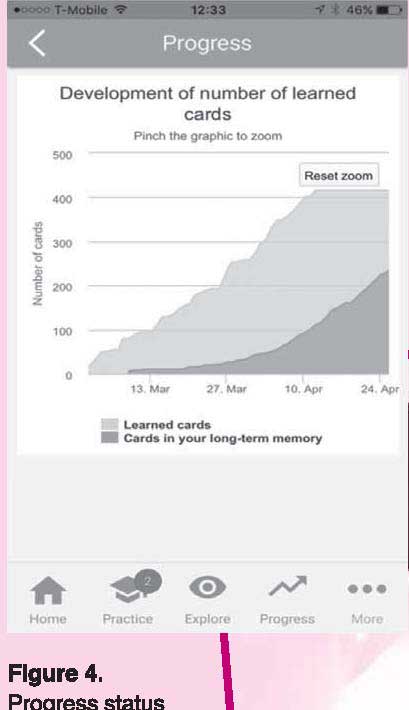
An
interesting feature that has been included in this app is the Hands Free mode.
This option is very useful while travelling or jogging, all one has to do is to
play any or all the cards in audio format both in the target language and in
English.
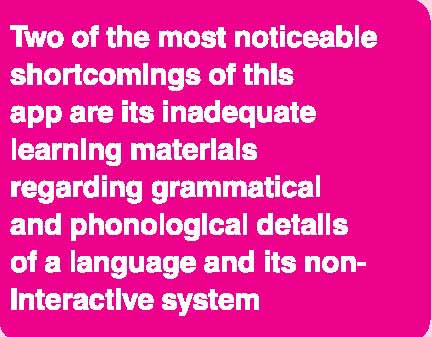
Weaknesses
In spite
of the aforementioned strengths, this app suffers from some weaknesses. For
instance, it is plausible to claim that MosaLingua is not that much rich in
offering a thorough learning system. In other words, learners using this app do
not fully learn about the grammar, the phonology, or the exceptions of the
target language. There are some not very complete grammatical points such as
the concept of plurality/singularity written underneath of each word. However,
if one wants to learn about grammar in more detail, they can go to the
‘Lessons’ category in the ‘Explore’ tab, and search for specific grammar rules
in the premium version. Furthermore, the interface graphics of this app are not
really playful. Although this fact could be justified by its philosophy with
its focus on effective learning, MosaLingua can be regarded as one of the less
enjoyable MALL apps in comparison to apps such as Duolingo.
Mutual
interaction and communication is one of the most significant factors in
learning an L2 (Swain, 1985). Unfortunately, this app does not give an
opportunity to learners to communicate with other learners from other countries
and cultures; that is to say, MosaLingua does not seem to be based on
interaction and communication.
Conclusion
To
summarize the discussion, there is no doubt that MosaLingua is an effective
language learning tool due to its scientifically sound foundations and its
creative expert team. The freedom it offers to its users in choosing their
preferences in all different aspects of learning a new language and the
well-designed categories of word and phrase exercises in addition to multimedia
bonus options (daily conversations as video and audio files) are inevitably
significant and beneficial. Yet, like other language learning apps, it suffers
from a number of drawbacks. Two of the most noticeable shortcomings of this app
are its inadequate learning materials regarding grammatical and phonological
details of a language and its non-interactive system. It should be pointed out
that the former feature is the problem of some other language learning apps
such as Memrise (see Eqbali & Nushi, 2017 for a review) which does not
encourage learners to choose those apps in the first place as their learning
tools. All in all, MosaLingua team could do better in the realm of MALL by
designing more detail-based materials, real-life communicative exercises, and
fancy graphics.
References
Ballance,
O.J. (2012). Mobile language learning: More than just ‘the platform’. Language
Learning & Technology, 16(3), 21-23.
Baturay,
M., Yıldırım, S., & Daloğlu, A. (2009). Effects of Web-Based Spaced
Repetition on Vocabulary Retention of Foreign Language Learners. Eurasian
Journal of Educational Research (EJER), (34).
Burston,
J. (2013). Mobile-assisted language learning: A selected annotated bibliography
of
implementation studies 1994–2012. Language Learning & Technology, 17(3),
157–224.
Chinnery,
G. M. (2006). Emerging Technologies: Going to the MALL: Mobile Assisted
Language Learning. Language Learning & Technology, 10(1), 9-16.
Godwin-Jones, R. (2011). Mobile apps for
language learning. Language Learning & Technology 15(2), 2-11
Kang, S.
H. (2016). Spaced Repetition Promotes
Efficient and Effective Learning: Policy Implications for Instruction. Policy
Insights from the Behavioral and Brain Sciences, 3(1), 12-19.
Lewis,
B. (2017). Spaced repetition: never forget
vocabulary ever again. Retrieved from
https://www.fluentin3months.com/spaced-repetition/
Nushi,
M., Eqbali, MH. (2017). Memrise: Does it hold up as a language learning tool?.
ROSHD FLT Journal, 32(1), 18-22
Shen,
R., Wang, M., & Pan, X. (2008). Increasing interactivity in blended
classrooms through a cutting-edge mobile learning system. British Journal of
Educational Technology, 39(6), 1073-1086.
Swain,
M. (1985). Communicative competence: Some roles of comprehensible input and
comprehensible output in its development. Input in second language acquisition,
15, 165-179.